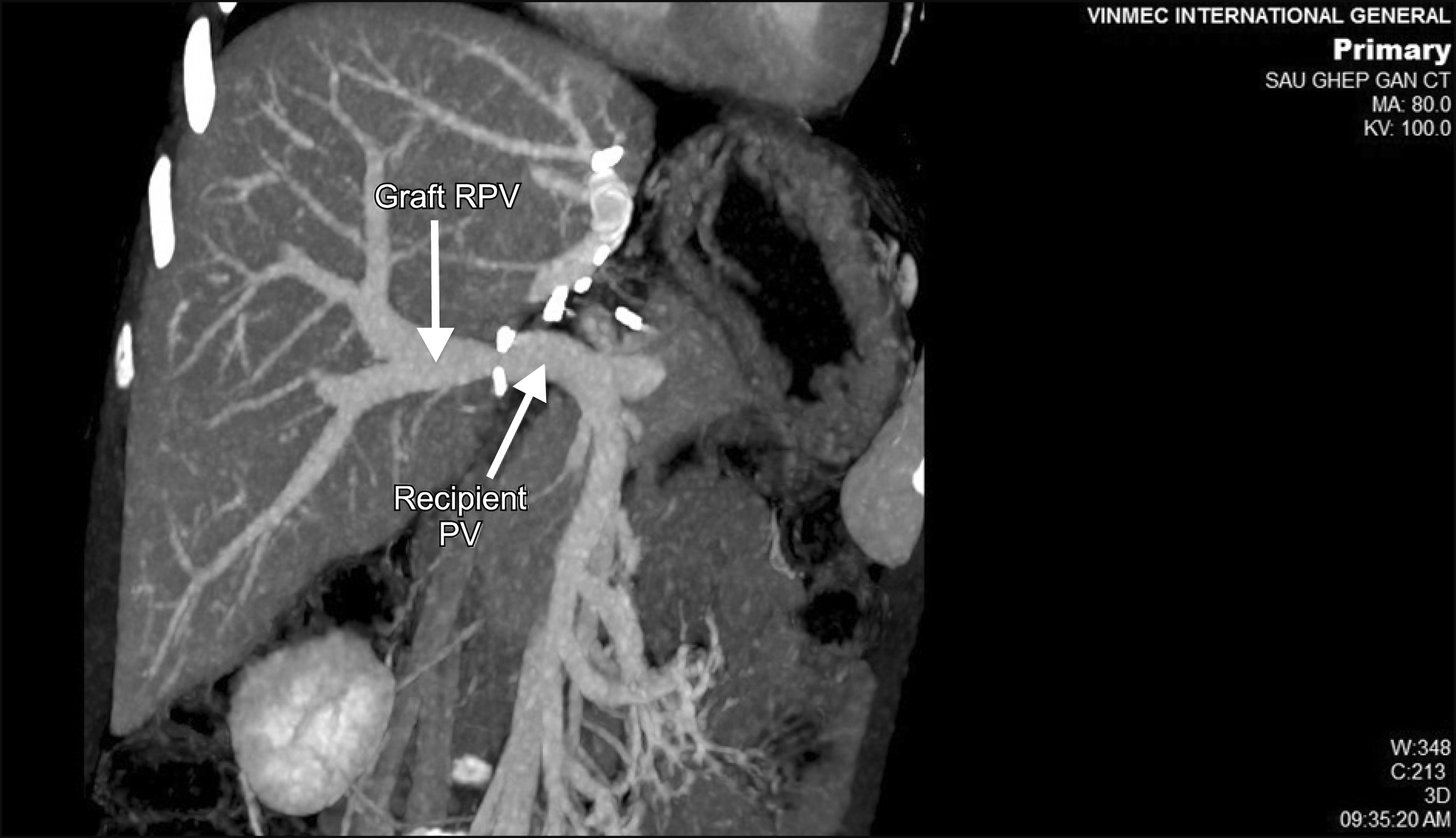Ann Hepatobiliary Pancreat Surg.
2020 May;24(2):203-208. 10.14701/ahbps.2020.24.2.203.
Living-donor liver transplantation for Abernethy malformation - case report and review of literature
- Affiliations
-
- 1HBP-Liver Transplant Center, Vinmec Times City International Hospital, Hanoi, Vietnam
- KMID: 2500807
- DOI: http://doi.org/10.14701/ahbps.2020.24.2.203
Abstract
- Abernethy malformation was named for the rare congenital absence of the portal vein (CAPV), also known as congenital extrahepatic portal-systemic shunts (CEPS). This could be classified as complete (type 1) or incomplete shunt (type 2) according to Morgan-Superina classification. Its presentation may show under variable signs and symptoms such as hepatopulmonary syndrome, hyper-ammonia, hepatic masses and liver failure…. This usually combined with other congenital anomalies (cardiac anomaly, trisomy…). This report presented a 10 year-old boy with growth retardation and mild mental recognition, intermittent hyperammonia, elevated liver enzymes, huge inoperable mass in the right liver. MS CT and MRI findings: hyperplasia of liver parenchyma with superior mesenteric vein confluenced with splenic vein before draining directly into the inferior vena cava (Abernethy anomaly type 1b). Living donor liver transplantation underwent using right lobe from his mother. Anatomopathology findings of the native liver showed chronic hepatitis with cirrhosis 4/6 Knodel-Ishak. Postoperatively, the patient still attained optimal liver function and has returned to normal life at 12-month follow-up. Liver transplantation was a reasonable indication for CAPV type 1. Living donor liver transplantation was effective and practical in the scarcity of donor organ.
Keyword
Figure
Reference
-
1. Abernethy J, Bank J. 1793; IX. Account of two instances of uncommon formation, in the viscera of the human body. Philos Trans R Soc. 83:59–66. DOI: 10.1098/rstl.1793.0010.2. Howard ER, Davenport M. 1997; Congenital extrahepatic portocaval shunts--the Abernethy malformation. J Pediatr Surg. 32:494–497. DOI: 10.1016/S0022-3468(97)90614-X. PMID: 9094026.
Article3. Morgan G, Superina R. 1994; Congenital absence of the portal vein: two cases and a proposed classification system for portasystemic vascular anomalies. J Pediatr Surg. 29:1239–1241. DOI: 10.1016/0022-3468(94)90812-5. PMID: 7807356.
Article4. Sokollik C, Bandsma RH, Gana JC, van den Heuvel M, Ling SC. 2013; Congenital portosystemic shunt: characterization of a multisystem disease. J Pediatr Gastroenterol Nutr. 56:675–681. DOI: 10.1097/MPG.0b013e31828b3750. PMID: 23412540.5. Brasoveanu V, Ionescu MI, Grigorie R, Mihaila M, Bacalbasa N, Dumitru R, et al. 2015; Living donor liver transplantation for unresectable liver adenomatosis associated with congenital absence of portal vein: a case report and literature review. Am J Case Rep. 16:637–644. DOI: 10.12659/AJCR.895235. PMID: 26386552. PMCID: PMC4581685.
Article6. Sakamoto S, Shigeta T, Fukuda A, Tanaka H, Nakazawa A, Nosaka S, et al. 2012; The role of liver transplantation for congenital extrahepatic portosystemic shunt. Transplantation. 93:1282–1287. DOI: 10.1097/TP.0b013e318250c157. PMID: 22617089.
Article7. Stringer MD. 2008; The clinical anatomy of congenital portosystemic venous shunts. Clin Anat. 21:147–157. DOI: 10.1002/ca.20574. PMID: 18161055.
Article8. Tanaka Y, Takayanagi M, Shiratori Y, Imai Y, Obi S, Tateishi R, et al. 2003; Congenital absence of portal vein with multiple hyperplastic nodular lesions in the liver. J Gastroenterol. 38:288–294. DOI: 10.1007/s005350300050. PMID: 12673454.
Article9. Kobayashi N, Niwa T, Kirikoshi H, Fujita K, Yoneda M, Saito S, et al. 2010; Clinical classification of congenital extrahepatic portosystemic shunts. Hepatol Res. 40:585–593. DOI: 10.1111/j.1872-034X.2010.00667.x. PMID: 20618456.
Article10. Takagaki K, Kodaira M, Kuriyama S, Isogai Y, Nogaki A, Ichikawa N, et al. 2004; Congenital absence of the portal vein complicating hepatic tumors. Intern Med. 43:194–198. DOI: 10.2169/internalmedicine.43.194. PMID: 15098599.
Article11. Niwa T, Aida N, Tachibana K, Shinkai M, Ohhama Y, Fujita K, et al. 2002; Congenital absence of the portal vein: clinical and radiologic findings. J Comput Assist Tomogr. 26:681–686. DOI: 10.1097/00004728-200209000-00003. PMID: 12439298.
Article12. Kamiya S, Taniguchi I, Yamamoto T, Sawamura S, Kai M, Ohnishi N, et al. 1993; Analysis of intestinal flora of a patient with congenital absence of the portal vein. FEMS Immunol Med Microbiol. 7:73–80. DOI: 10.1111/j.1574-695X.1993.tb00384.x. PMID: 8364525.
Article13. Nakasaki H, Tanaka Y, Ohta M, Kanemoto T, Mitomi T, Iwata Y, et al. 1989; Congenital absence of the portal vein. Ann Surg. 210:190–193. DOI: 10.1097/00000658-198908000-00009. PMID: 2667474. PMCID: PMC1357827.
Article14. Alonso-Gamarra E, Parrón M, Pérez A, Prieto C, Hierro L, López-Santamaría M. 2011; Clinical and radiologic manifestations of congenital extrahepatic portosystemic shunts: a comprehensive review. Radiographics. 31:707–722. DOI: 10.1148/rg.313105070. PMID: 21571652.
Article15. Kim MJ, Ko JS, Seo JK, Yang HR, Chang JY, Kim GB, et al. 2012; Clinical features of congenital portosystemic shunt in children. Eur J Pediatr. 171:395–400. DOI: 10.1007/s00431-011-1564-9. PMID: 21912894.
Article16. Pupulim LF, Vullierme MP, Paradis V, Valla D, Terraz S, Vilgrain V. 2013; Congenital portosystemic shunts associated with liver tumours. Clin Radiol. 68:e362–e369. DOI: 10.1016/j.crad.2013.01.024. PMID: 23537576.
Article17. Shinkai M, Ohhama Y, Nishi T, Yamamoto H, Fujita S, Take H, et al. 2001; Congenital absence of the portal vein and role of liver transplantation in children. J Pediatr Surg. 36:1026–1031. DOI: 10.1053/jpsu.2001.24731. PMID: 11431769.
Article18. Sibulesky L, Taner CB, Willingham DL, Satyanarayana R, Peiris P, Krishna M, et al. 2009; Orthotopic liver transplantation for hepatic adenoma in a patient with portal vein agenesis. Open Transplant J. 3:22–25. DOI: 10.2174/1874418400903010022.
Article
- Full Text Links
- Actions
-
Cited
- CITED
-
- Close
- Share
- Similar articles
-
- Portal vein fenestration: a case report of an unusual portal vein developmental anomaly
- A Case of Congenital Extra Hepatic Portocaval Shunt(Abernethy Malformation Type 2) with a very LargeLiver Mass and an Atrial Septal Defect
- Liver retransplantation for adult recipients
- Left at right heterotopic implantation of left liver graft in adult-to-adult living donor liver transplantation: the technical concern for decision-making
- Unilateral Versus Bilateral Biliary Drainage for Post-Transplant Anastomotic Stricture






